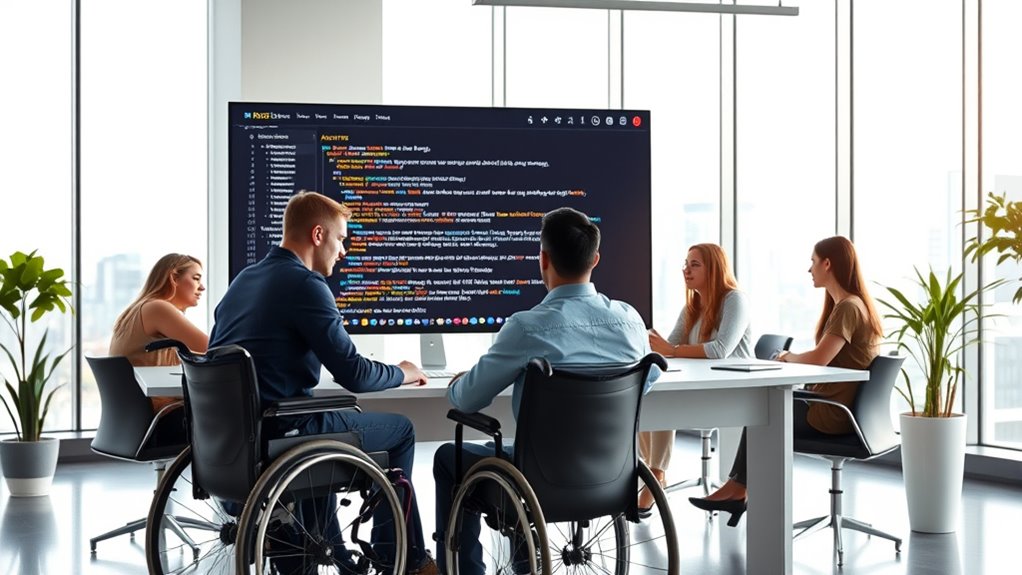Accessibility offers a clear SEO advantage by making your website easier for search engines to crawl, understand, and index. When you design with accessibility in mind, you create a logical structure, use descriptive headings, and include alt text, all of which boost your content’s discoverability. Plus, accessible sites often perform better on speed and mobile usability, improving rankings. Keep exploring to uncover how integrating accessibility can give your site a competitive edge.
Key Takeaways
- Accessibility features improve search engine crawlability and indexing through clear site structure and descriptive content.
- Using alt text and structured headings boosts keyword relevance and content clarity for SEO.
- Accessible websites typically load faster and perform better on mobile, enhancing user experience and search rankings.
- Demonstrating inclusivity through accessibility enhances brand reputation and aligns with search engine trust signals.
- Accessibility expands content reach to diverse audiences and devices, increasing traffic and potential conversions.

Accessibility isn’t just a moral obligation; it also offers a significant SEO advantage. When you design your website with accessibility in mind, you’re making it easier for search engines to crawl, understand, and index your content. Search engines like Google prioritize user experience, and accessible websites inherently provide a better experience for all users, including those with disabilities. By ensuring your site is navigable via keyboard, screen readers, and other assistive technologies, you help search engines discover and interpret your content more effectively. This can lead to improved rankings because your site becomes more inclusive and easier for algorithms to evaluate.
Accessible websites improve search engine understanding and rankings by enhancing crawlability, user experience, and content clarity.
Implementing accessibility features often involves optimizing your site’s structure. Clear headings, descriptive alt text for images, and logical content hierarchy not only assist users with visual impairments but also make it simpler for search engines to grasp your content’s context. When images include descriptive alt tags, you’re providing additional keywords that can boost your SEO while making your site more accessible. Similarly, a well-organized site with intuitive navigation helps search engines understand your site architecture, prioritizing important pages and ensuring your content is discoverable. These practices create a seamless experience for users and crawlers alike, increasing the likelihood that your pages will rank higher in search results.
Furthermore, accessibility encourages better mobile performance and faster load times, which are critical factors in SEO rankings. Many accessibility improvements, such as optimizing images, reducing clutter, and streamlining code, also improve your site’s performance metrics. Faster-loading pages reduce bounce rates and increase user engagement, signals that search engines interpret as indicators of quality. When your site is accessible, it’s often more performant, which means users are more likely to stay longer and interact with your content—both positive signals for SEO.
Beyond technical benefits, embracing accessibility demonstrates your commitment to inclusivity and social responsibility, which can enhance your brand reputation. Search engines are increasingly prioritizing websites that reflect positive user values and social consciousness. This can translate into better visibility and trustworthiness, ultimately driving more traffic and conversions. Additionally, making your site accessible aligns with content accessibility standards, which is increasingly recognized as a best practice in digital marketing. In a competitive digital landscape, accessibility becomes a strategic advantage that complements your SEO efforts. It ensures your content reaches a broader audience, including people with disabilities or those using different devices and technologies, expanding your reach and reinforcing your site’s authority and relevance.
Frequently Asked Questions
How Does Accessibility Impact Local SEO Rankings?
Accessibility directly impacts your local SEO rankings by ensuring all users, including those with disabilities, can access your website easily. Search engines favor accessible sites because they provide a better user experience, leading to higher engagement and lower bounce rates. When your site is accessible, it’s more likely to appear in local searches, making it easier for potential customers nearby to find and choose your business over competitors.
Are There Specific Tools to Measure Website Accessibility?
Yes, you can use tools like Lighthouse, WAVE, and Axe to measure your website’s accessibility. These tools analyze your site’s structure, identify issues, and provide actionable insights. You simply run the scans, review the reports, and make necessary improvements. By regularly checking your accessibility, you make certain your website is usable for everyone, boost your SEO, and create a more inclusive online presence.
Can Accessibility Improvements Directly Boost Organic Traffic?
Yes, accessibility improvements can directly boost your organic traffic. When you make your website more accessible, search engines find it easier to crawl and index your content, leading to better rankings. Additionally, accessible sites reach a broader audience, including users with disabilities, increasing your potential visitors. By enhancing user experience for everyone, you naturally improve your SEO performance, attracting more organic traffic and fostering greater engagement.
What Are Common Accessibility Mistakes Affecting SEO?
You might overlook some accessibility mistakes that hurt your SEO, like missing alt text on images or using improper heading structures. These issues make your site harder to navigate for users with disabilities and can reduce your search engine visibility. You also risk ignoring keyboard navigation and low contrast text, which frustrate visitors and bots alike. Fixing these mistakes not only improves accessibility but also boosts your overall search rankings.
How Does Accessibility Influence Mobile Search Optimization?
Accessibility considerably influences your mobile search optimization by ensuring your site is easy to navigate and understand on small screens. When you optimize for accessibility, you improve your site’s readability with clear headings, larger buttons, and alt text, which helps search engines crawl and index your content better. As a result, your site becomes more user-friendly for all users, boosting your rankings and visibility in mobile search results.
Conclusion
By prioritizing accessibility, you’re not only creating an inclusive experience but also boosting your SEO. Did you know that 71% of users with disabilities are more likely to stay longer on accessible websites? Implementing accessible features can improve your search rankings and reach a wider audience. So, make accessibility a core part of your SEO strategy—you’ll enhance user experience and gain a competitive edge in search results.









